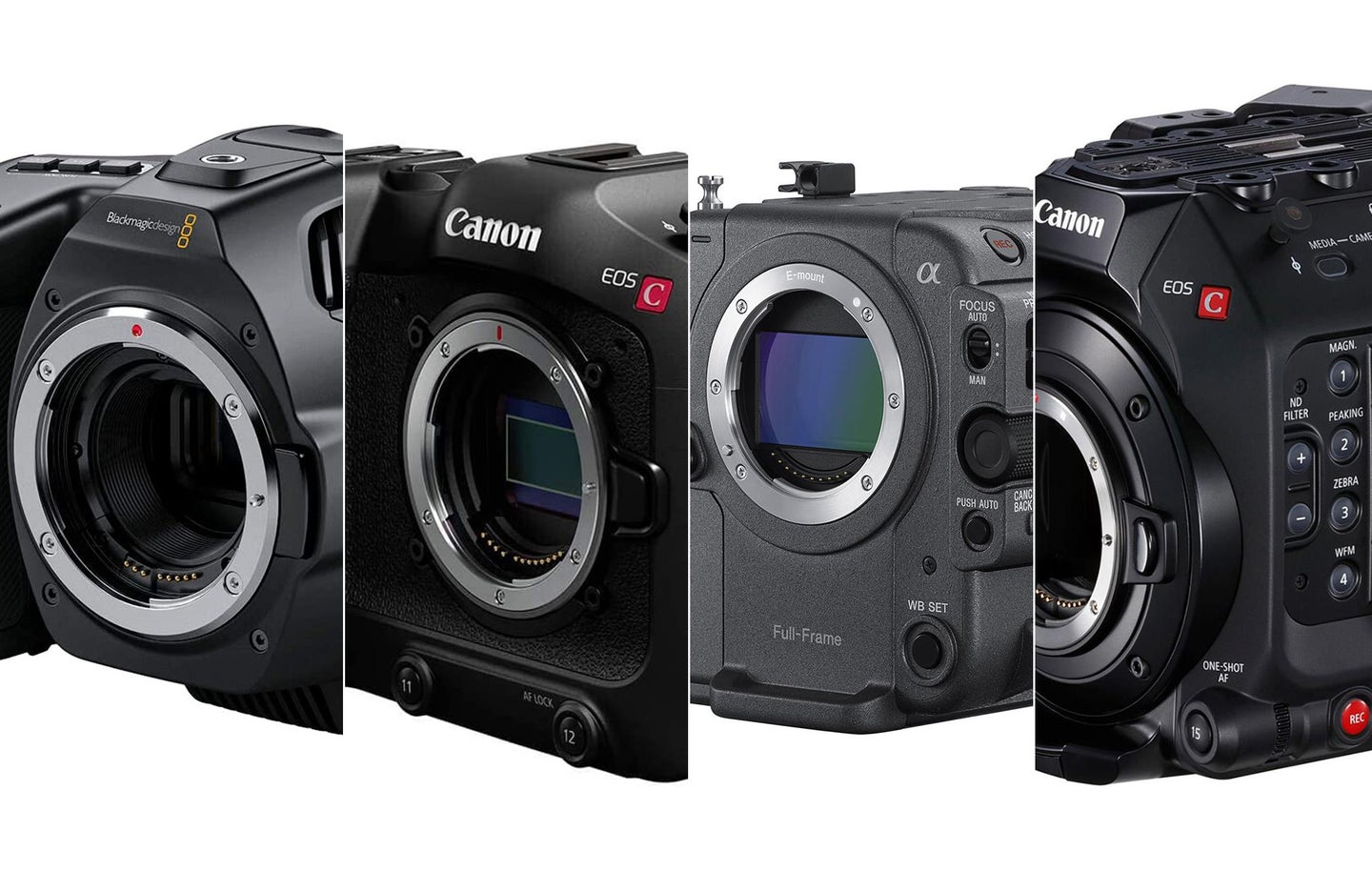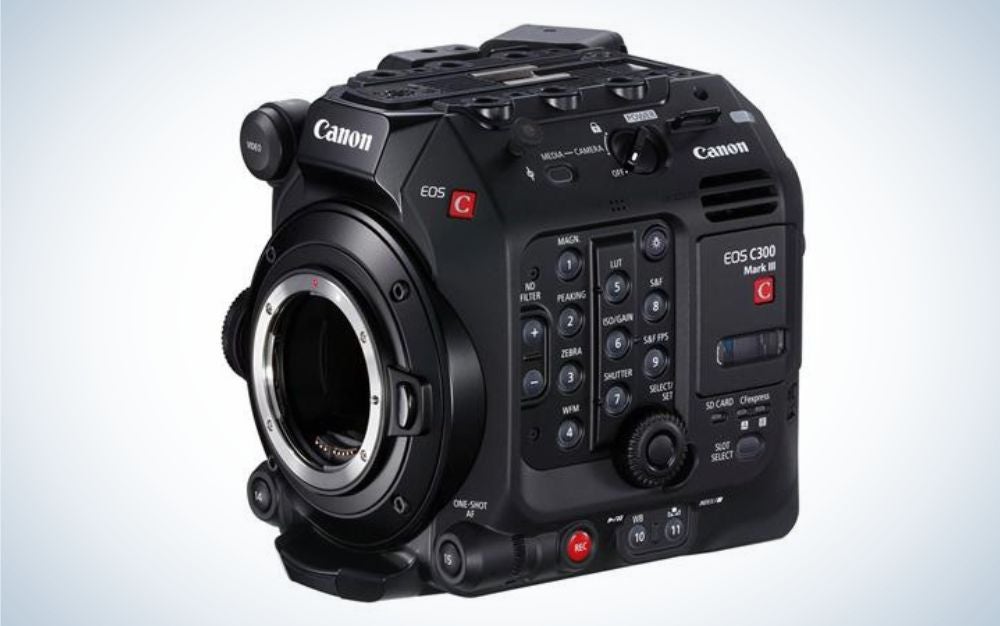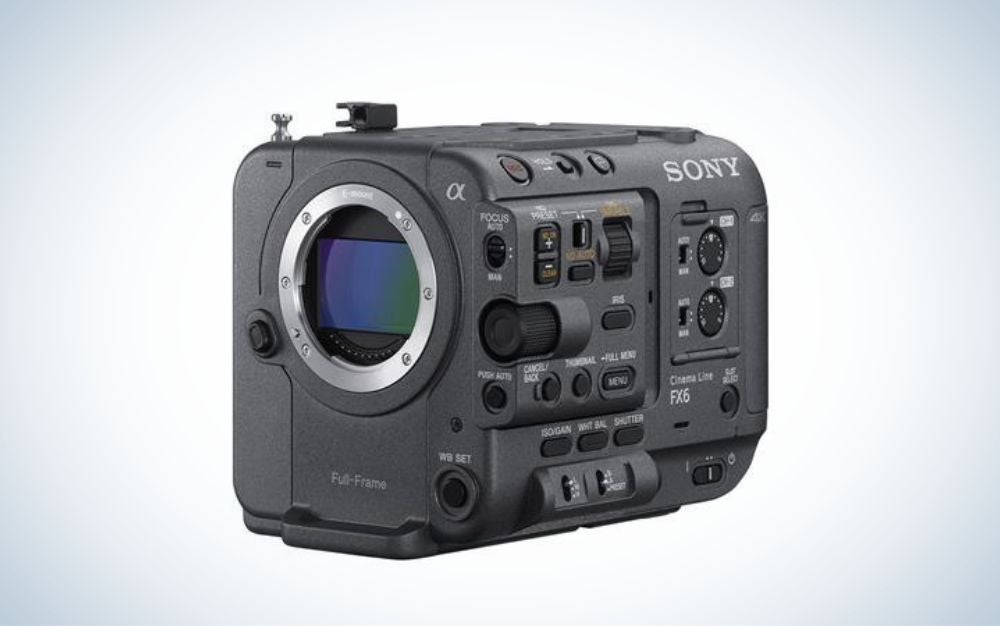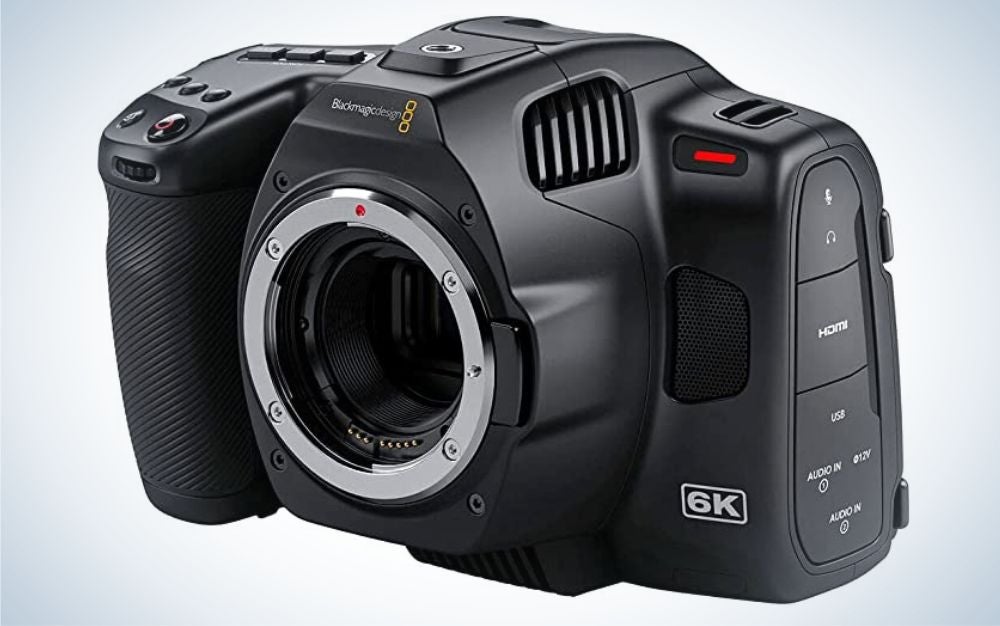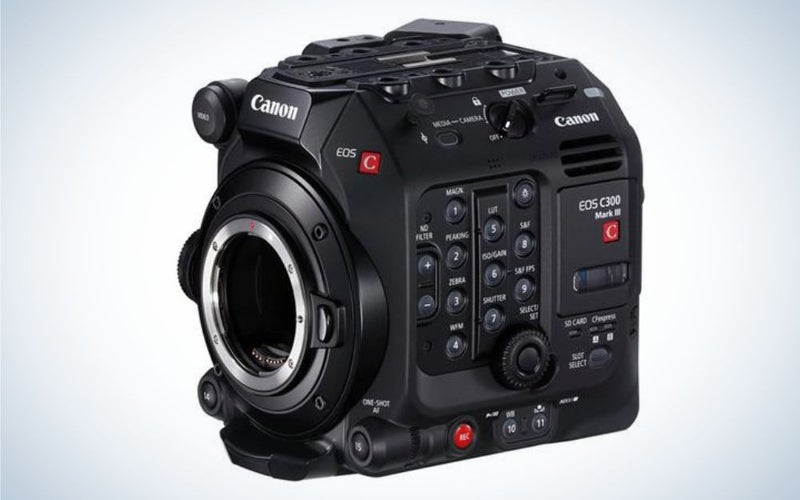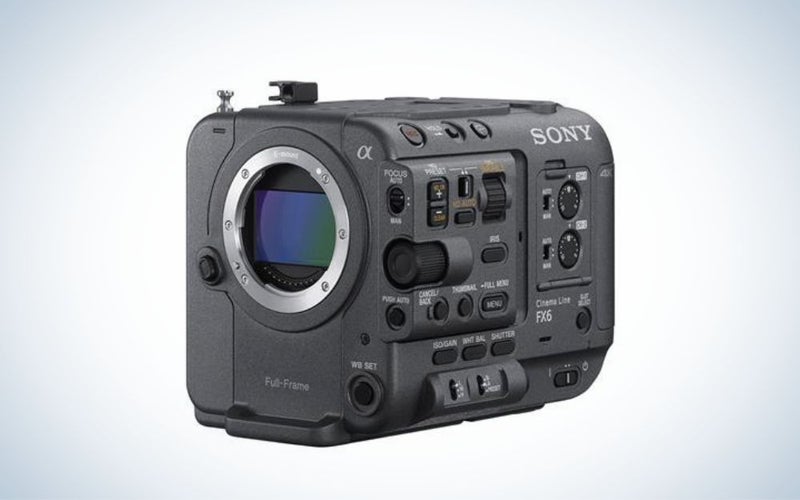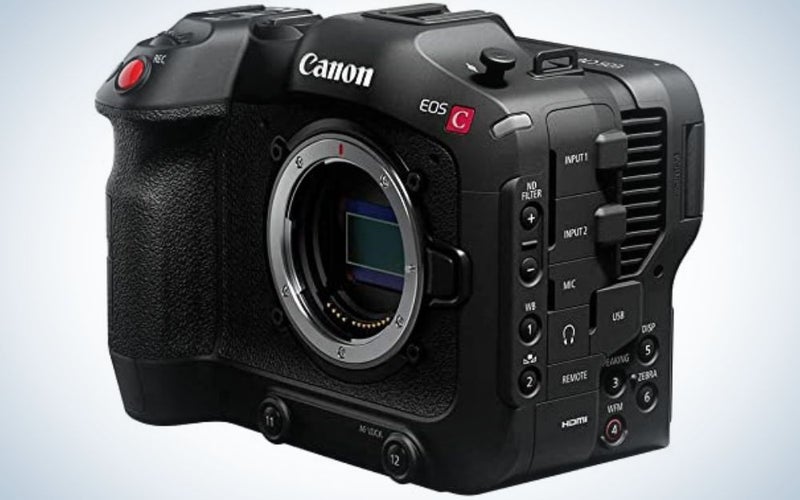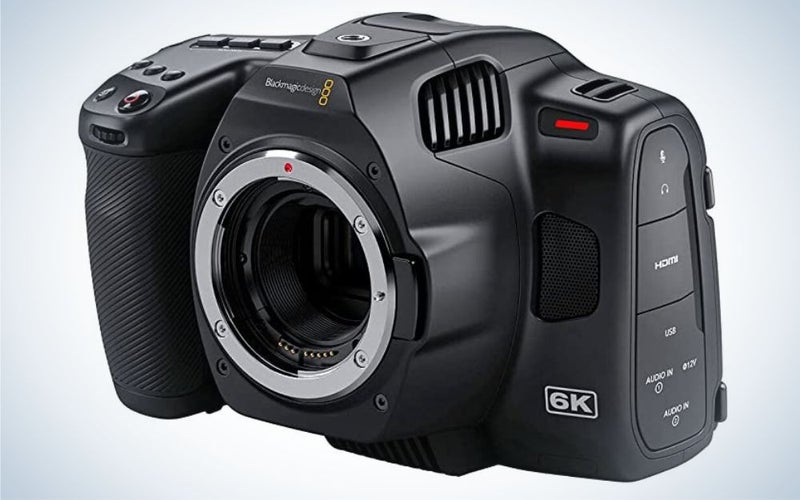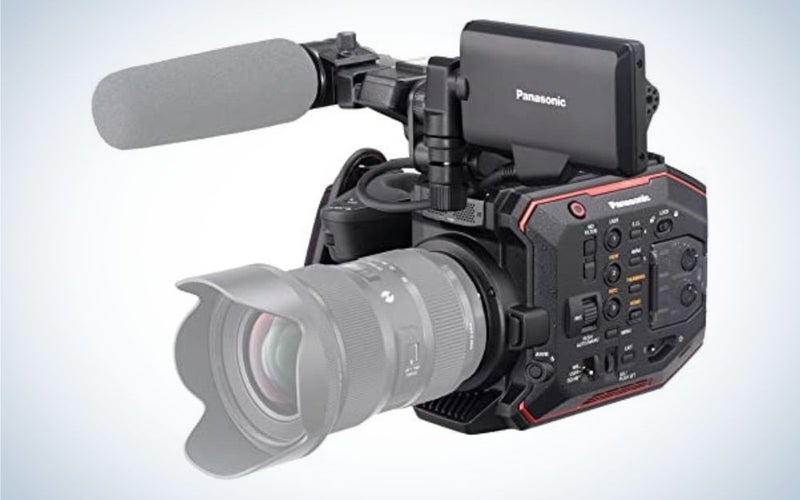We may earn revenue from the products available on this page and participate in affiliate programs. Learn more ›
Cinema cameras deliver high-quality footage and provide advanced features not commonly found on the kind of camcorder you’d use to shoot your family reunion. (Unless you’re Stanley Kubrick, perhaps.) Generally, digital cinema cameras feature interchangeable lens mounts, Super35 or full-frame sensors, resolutions that start at 4K, high dynamic range, an in-camera log gamma setting, and decent low-light performance. They also shoot in relatively uncompressed file formats (including Apple ProRes HQ, MXF, and different flavors of raw), and can do so at higher frame rates for smooth slow-motion footage. Other common features that might not be exclusive to cinema cameras include balanced audio inputs, ND filters, and HDMI or SDI video outs. All this is in the service of capturing footage that looks fantastic on TV or the big screen.
But these cameras aren’t for everyone. They’re expensive, for one thing—with a couple exceptions, over-the-counter cinema cameras cost anywhere from $5,000 to $12,000 dollars for just the bodies. More than that, the cameras require a certain amount of experience to use correctly. These cameras reward people who understand the fundamentals of cameras and shooting. Which isn’t to say you need to be a professional director of photography to use one. But taking the time to practice and learn and really understand how these cameras work will prevent a fair amount of frustration.
Given the level of investment required, buying a cinema camera can be a daunting task. It’s important to do your research, and to that end, we’ve put together a list of what we feel are the best cinema cameras to help you on your way to your first Oscar nomination.
- Best 4K: Canon C300 Mk III
- Best full-frame: Sony FX6
- Best small: Canon EOS C70
- Best affordable: Blackmagic Pocket Cinema Camera 6K Pro
- Best compact: Panasonic AU-EVA1
How we picked the best cinema cameras
When evaluating the best cinema cameras, I looked to my own experience as a professional cinematographer and cameraman, and also consulted closely with colleagues. I read industry web sites for reviews and real-world evaluations, and checked in on buyer feedback for a more wide-ranging look at people’s impressions of these cameras. Spec sheets and white-papers rounded out the research.
I selected five favorite cameras from four companies out of a field of 10 (made by seven different manufacturers). I focused foremost on the quality of the footage, and how well it achieved my artistic goals. Beyond that, I dug into specs: image resolution, dynamic range, shooting format, frame rate, cost, size, lens mount, recording media, and overall ergonomics. These factors play a big part in how I choose a camera for myself.
The best cinema cameras: Reviews & Recommendations
Best 4K: Canon C300 MK III
Adorama
Why it made the cut: The C300 MK III’s wide dynamic range and dual native ISO work with Canon’s legendary color science to deliver a gorgeous 4K image under a variety of shooting conditions.
Specs
- Resolution: 4K
- Sensor size: 26.2 x 13.8 (Super35)
- Lens Mount: EF or PL
Pros
- 16 stops of dynamic range
- 4K up to 120 fps, and 2K up to 180 fps
- 10- and 12-bit Cinema RAW Light at 4K
Cons
- Much more expensive than other cameras on this list
Canon’s earlier C300 Mk II was a workhorse on commercial and documentary shoots. The newest iteration of the camera adds dual native ISO and 16 stops of dynamic range, making a great camera even better. It records up to 120 fps at 4K, or 180 fps at 2K (using a cropped sensor). The C300 Mk III has fantastic low-light capabilities, and the powerful auto-focus and mechanical image stabilization makes it ideal for run-and-gun work. The camera records internal 4K Cinema RAW Light and high-quality MXF at 4:2:2, and card slots include two CFexpress for footage, and a single SDXC for photos and other data. You can even record low-res proxy files while shooting for a much faster post-production workflow. The C300 includes a 4.3-inch display, dual XLR audio inputs, and a lens mount that can be switched between EF or PL. In fact, the modular design lets the camera strip down easily for use on a gimbel, crane, or other shooting situations. Unfortunately, all this power comes with a hefty price-tag, and many of the features can be found, in various combinations, on cameras that cost less. But it’s tough to match the power, image quality, and flexibility of this cinema camera.
Best full-frame: Sony FX6
Adorama
Why it made the cut: Sony packs many professional features into this (relatively) affordable, light-weight, full-frame cinema camera, making it an industry workhorse—and one of our top picks.
Specs
- Resolution: 4K
- Sensor size: Full Frame
- Lens Mount: Sony FE
Pros
- 10-bit internal 4:2:2 recording
- Variable ND filters
- Compact, light-weight size
- Cheaper than most full-frame cinema cameras
Cons
- No internal Raw recording
- Requires an adapter for non-Sony lenses
The Sony FX6’s full-frame sensor delivers gorgeous footage with tight depth-of-field and beautiful bokeh, and it’s proven itself in many professional applications. It features the same 10.2MP CMOS Exmor R sensor as the mirrorless A7S III, but tweaked to improve low-light performance. The 15 stops of dynamic range open up lots of creative opportunities for filmmakers, and the camera’s speedy auto-focus (when using Sony lenses) and lightweight design make it excellent for run-and-gun. The FX6 shoots up to 120 fps in 4K UHD, and up to 240 fps in HD, and it can send 4K 16-bit raw footage to external recorders. Mounting points throughout the FX6’s body accommodate external monitors, wireless audio receivers, and various handle configurations without the need for a cage. While internal raw would be nice, lightweight external monitors with built-in recorders aren’t too expensive an investment and perform wonderfully. It also tops out at only 4K compared to the 6K resolutions found on some other full-frame cameras, but most content creators won’t find that problematic—remember, the digital cameras that shot the Star Wars prequels were only 2K, so you’re already one with the force!
Best small: Canon EOS C70
Amazon Renewed
Why it made the cut: Professional features found on bigger cameras burst from the compact and lightweight C70, making this cinema camera as flexible as it is unobtrusive.
Specs
- Resolution: 4K
- Sensor size: Super35
- Lens Mount: RF
Pros
- 120 fps at 4K UHD
- 16 stops of dynamic range
- Small and light
Cons
- EF Lenses require adapter
The Canon C70 takes many of the features that make the C300 Mk III such a great camera and fits them into a small body that’s perfect for travel shoots or situations where you’d prefer keeping a low profile. (It also costs about half!) It shoots up to 4K DCI footage, and has a whopping 16 stops of dynamic range. Files are 10-bit XF-AVC. It’s not raw, but it still looks great and provides lots of room to stretch and twist during post-production. And with a recent firmware update, the camera now supports raw recording. A wide ISO range makes this an excellent camera for low-light situations, and Canon’s highly accurate autofocus makes run-and-gun shoots much easier. Footage is recorded to dual SD/SDHC/SDXC slots.
The RF lens mount has a decent selection of lenses, and their smaller size helps keep the camera compact. You can easily adapt it to use with EF glass using one of Canon’s adapters—if you don’t mind some extra bulk. (It’s too bad Canon didn’t include a basic adapter with the camera given the prevalence of EF lenses in many shooters’ kits.) The C70 has a pair of mini XLR audio inputs and +48 V phantom power for sound recording, and also accepts a stereo TRS connector.
Best affordable: Blackmagic Pocket 6K Pro
Blackmagic Design
Why it made the cut: Internal 6K raw, built-in ND filters, top-tier color science, and a compact size to match it’s compact price makes this an affordable powerhouse of a camera.
Specs
- Resolution: Up to 6K
- Sensor size: Super35
- Lens Mount: EF
Pros
- Up to 6K internal raw recording
- 13 stops of dynamic range
- Built-in ND filters
- Dual native ISO
Cons
- Limited auto-focus
- Awkward ergonomics
Blackmagic has a reputation for delivering high-quality cameras for seemingly impossibly low prices, and the 6K Pro—which builds on the original 6K—builds on this promise. It has a Super35 sensor that shoots 6K raw internally, or up to 4K in ProRes 4:2:2 HQ, and records to either a CFast card or a less-expensive external SSD connected via USB-C. It features dual native ISO at 400 and 3200, making it a solid (if not stellar) performer in low light. While 13 stops of dynamic range is a little lower than the other cameras on our list, it’s still enough to deliver rich, cinematic footage. The camera’s 5-inch, rear-mounted, tiltable screen is bigger than the ones found on most cameras, and it makes framing shots a pleasure. Conveniently located buttons provide quick access to important features like focus-assist and exposure zebras, while other settings are accessible through an easy-to-use touch-screen menu. The camera can shoot 60 fps at 4K, or 120 fps at HD resolutions; it’s not top-of-the-line, but it still looks nice and smooth. The camera lacks image stabilization, and the touch-implemented auto-focus is only useful with immobile objects—don’t expect anything like Canon’s face-tracking system when shooting run-and-gun. The camera’s formfactor almost demands additional rigging to accommodate a top handle and external battery (needed because the internal battery doesn’t last anywhere near long enough). This can increase the price, but even with a larger battery system in place, it’s still much less expensive than cameras that can’t deliver anywhere near this level of performance. Read our full review of the Blackmagic 6K Pro here.
Best compact: Panasonic AU-EVA1
Panasonic
Why it made the cut: The compact size of the EVA1 hides a powerful set of features, making this an excellent choice for shooters who want a traditional formfactor without too much bulk.
Specs
List 3 key specs/dimensions readers use when evaluating this kind of product. Examples include:
- Resolution: 4K
- Sensor size: Super35
- Lens Mount: EF
Pros
- Dual native ISOs
- Weighs just 2.65 pounds without lens or accessories
- External 10-bit raw up to 5.7K
Cons
- High amount of screen glare
- Auto focus could be better
Panasonic’s EVA1 uses a 5.7K CMOS sensor to create oversampled 4K footage that’s pin-sharp with excellent color fidelity. When using an external recorder, like the Atomos Shogun, you can capture 10-bit raw at 5.7K. Dual native ISOs at 800 and 2500 help the camera perform better when the lights are dim. The EVA1 features traditional video-camera style, but at an almost shockingly small size. Stripped down, it’s easy to mount the Panasonic on a gimbel or crane, and it’s an excellent option for situations where you don’t want to draw too much attention to the camera. One nice feature: The 3.5-inch monitor doesn’t just swivel, you can completely reposition it. On the other hand, the screen is extremely reflective and seeing it clearly requires a hood when shooting in bright sulight. It would be nice if the EVA1 included an electronic viewfinder for those situations, and it might be worth investing in one from a third party.
Things to consider before buying the best cinema cameras
In order to navigate the world of cinema cameras, it’s important to understand some key concepts, specs, and tech that goes into making them such powerful tools.
Resolution
Resolution is measured in pixel count, and it describes the amount of detail a camera’s image sensor can capture. The more detail, the sharper the image and the easier it is to blow up to a large size before quality begins to degrade. High-definition footage is 1920 pixels wide by 1080 pixels high, and is usually the lowest resolution you’ll find in a cinema camera. 4K is twice the resolution of HD, and comes in two flavors: 4K DCI (4096 x 2160) and 4K UHD (3840 x 2160). Most cinema cameras can shoot in both, with 4K UHD maintaining the 16:9 aspect ratios commonly found on 4K TVs. All cinema cameras can shoot in 4K. From there, you might also find cameras shooting in 6K, 8K, or even 12K. Having a higher resolution doesn’t necessarily mean the camera is better, only that it can pack more detail into an image. But the quality of that image depends on so many other factors. Resolution is important, but don’t consider it in a vacuum.
Sensor size
Cinema cameras usually use full-frame or cropped Super35 sensor sizes. Sometimes you’ll also find smaller Super16 sensors on cameras that use micro4/3 lens mounts, but these are less common. Super35 sensors are most common, and look fantastic, but as the price on full-framed sensors continues to drop, more and more cameras are taking advantage of their ability to capture more light and deliver tighter depth-of-field.
Raw video
Raw video is video that’s captured directly from the sensor without any sort of processing by the camera. There are no color or contrast curves applied to the footage, and usually no (or very little) compression. This provides the best image possible, but it requires a lot of post-production work to bring out all that quality. On the flip side, things like white balance and exposure can be easily manipulated in post to fix problems in the footage. Many of the more expensive cameras can shoot raw internally, and even more can send a raw signal out of the camera to be recorded by external devices. The biggest downside to shooting raw is that the files are sometimes larger than those of other formats, and they require adding a few extra steps to the post-production workflow.
Dynamic range
Dynamic range is the contrast ratio between the darkest and brightest tones that a camera can capture in a single exposure. In other words, in a single shot, how dark can something get before sinking into inky blackness, and how light can something else be before it blows out and turns white with no details. It’s measured in stops. Think of it this way: The human eye has a dynamic range of about 21 stops. When you step into a room on a sunny day, you can see the trees outside the window, the couch and chair in the middle of the room, and the dog resting in the shadows under a desk all at the same time. Your eye doesn’t need to expose for one end of the scene or the other. Image sensors, though, aren’t as good as the human eye, and you’ll need to set exposure to “see” the tree outside or the dog in the shadows—but you won’t be able to see both without manipulating the lighting.
The sensors found on inexpensive camcorders have dynamic ranges of about 6 or 7 stops, which conforms to the rec.709 TV standard. iPhones actually do a little better, coming in around 9 stops. Cinema cameras, on the other hand, have dynamic ranges between 13 and 16 stops, which is remarkably close to that of the human eye. (Film also had a similar dynamic range, for the old-school among you.)
Having a higher dynamic range is never a bad thing, but just like resolution, it’s not the only factor contributing to image quality. A camera with a 13-stop dynamic range can still produce footage that’s as nice as one with a range of 16 stops—but the filmmaker will need to be more deliberate about exposure and lighting.
Log gamma settings
Log gamma profiles are shooting settings found on cinema cameras that allow them to capture the widest dynamic range. If you’re looking for the best image quality, this is what you’ll set your camera to when you shoot. Be warned: Log profiles look washed out when viewed on a camera’s monitor unless LUTs are applied to the monitor. (LUTs, or Look-Up Tables, are like presets that take log footage and give it a certain look when viewed through monitors. These don’t affect the footage directly, just how we see it, and can be used to give a sense of what the shots will look like after they’ve been color graded.) Log settings are proprietary from camera manufacturer to camera manufacturer—Sony has SLog3, Canon has CLog, Blackmagic calls their log setting “cinema mode,” and so on. Be sure to read your camera’s manual to get the shooting settings right!
Frame-rate
Cinema cameras shoot in many different frame-rates, from the standard 29.97 and 23.98, to much higher ones that deliver lush slow-motion footage. The maximum frame-rate is often dependent on the camera’s resolution, but 4K at 60 or 120 fps isn’t uncommon these days.
Lenses
Cinema cameras use interchangeable lenses using a variety of mounts. Many accommodate PL or Canon’s EF mounts, Sony’s cameras use their E mount system, and some cameras use the micro 4/3 system. Adaptors can often help you use glass with one type of mount on a camera with another—check and see what’s available before assuming any glass you might already own works with a particular camera. Most cinema cameras sell without lenses, so don’t forget to budget for them.
Audio
Most cinema cameras have two, balanced XLR inputs (though some, like Blackmagic’s line of Pocket Cinema cameras, use mini-XLRs), and they can record high bit-rate, professional-quality audio. They also usually feature +48V phantom power for mics needing it.
Customization
Cinema cameras are designed to be customized to various degrees by a camera operator. Many situations call for the addition of rails, handles, matte-boxes, focus wheels, external monitors, different battery systems, or any number of other bits of “gack,” as a cameraman friend of mine calls it. Cinema cameras usually have industry standard 4/20 mounting points for some of this equipment, or are can be put in cages designed to protect the camera and provide places to attach accessories.
FAQs
Q: What is the highest resolution cinema camera?
Right now, the highest resolution cinema camera is probably the 9×7, a 65-megapixel camera invented by Pawel Achtel and Mark Horstman. It’s designed for VFX, VR, giant-screen, and IMAX productions. It costs about $145,000, last we checked, which is why it didn’t seem practical to include it in our list.
Q: How many cameras do you need to shoot a movie?
To shoot a movie, you need at least one camera! But beyond that, it depends entirely on the type of movie you’re shooting, your workflow, your budget, and any number of different factors. But definitely start with one.
Q: Can you shoot a movie with an iPhone?
You can definitely shoot a movie with an iPhone. If it captures footage, you can shoot a movie with it. However, you might be able to achieve some of the visuals you get from a cinema camera, with its larger sensor, wider dynamic range, and better lenses. For instance, it’s hard to achieve tight depth of field using an iPhone. But in the end, the best camera is the one you’ve got on you, and if an iPhone’s all you’ve got, then go for it!
Q: How much is the average movie camera?
The average movie camera that’s designed for over-the-counter purchase costs around $7,000. Some higher-end models approach $12,000, while some excellent entry level shooters are around $3,000-$5,000. On the other hand, the types of cameras used on Hollywood films can cost anywhere from $50,000 to the low six figures. And that’s not including lenses. In the world of filmmaking, “expensive” is a very relative word.
Q: Are DSLRs good for filmmaking?
DSLRs can be good for filmmaking, but it depends on the kind of look you’re hoping to achieve, the resolution in which you want to shoot, and whether or not you want to shoot raw. DSLRs can produce excellent footage, but they generally don’t pack in the specs found on dedicated cinema cameras. (Though some come close!)
Q: Which camera is best for filmmaking?
The best camera for filmmaking is the one you’ve got. It’s a cliché, but it’s true. No single camera is perfect for every project, but having no camera at all guarantees you won’t shoot a frame. To find the best camera, first consider the type of movie you want to make. Documentaries have different requirements than VFX-heavy science-fiction epics. Look at your budget and ask yourself which camera does what you need it to do at a price you can afford? In the end, let the type of movie you’re making and the style of shooting you’ll be doing guide you when choosing the right camera.
Final thoughts on the best cinema cameras
When looking at cinema cameras, it’s important to first ask yourself what kind of projects you’ll be doing. The camera that’s best for commercial work might not be best for run-and-gun documentaries. That said, all good cinema cameras deliver a base level of quality that’s going to elevate whatever you shoot. That’s why it’s not always easy to say which is best. That said, I’m a big fan of the Canon C300 Mk III. Canon’s always impressed me with its color science, and the auto-focus is fantastic when trying to capture real life while on the move. I also really enjoy Blackmagic’s line of Pocket cameras, particularly the 6K pro. It’s affordable and powerful, and I’ve used it myself on many documentary features and series. With a little bit of rigging, they’re versatile tools that support your creativity.
